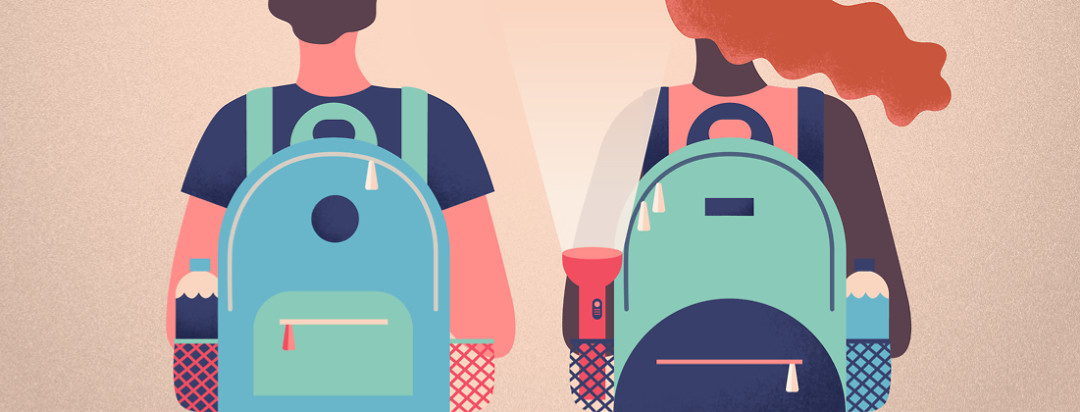Parkinson’s Natural Disasters Preparedness
September is National Preparedness month! With the devastation of Hurricane Harvey unfolding and the oncoming threat of Irma off the Atlantic coast, thinking of natural disasters is well… natural. But when you toss Parkinson’s into the party, thinking of the next big one can give you a panic attack.
As Parkies, we try to be ready for anything. This gives us a feeling of being in control over our unpredictable lives. However, preparing for natural disasters is crucial to ensure you and your family will be safe. First thing is to get your ducks in a row. Create a plan and then prepare for any disaster heading your way, including a zombie apocalypse.
I recommend creating a “Get home bag” which is a backpack to leave in your car and a “Bug out bag” which can be a large duffle bag or plastic tub that is easy for you to retrieve at home. So what’s the difference between the 2 bags?
Get home bag
A "Get home bag" is a backpack stored in your car, that is easy to carry and will provide you supplies for a temporary amount of time, enabling you to get home safely. This could include a large-scale disaster such as an earthquake, or the minor inconvenience of car congestion. What you put into your “Get home bag” (GHB) could include:
- A waterproof pouch that contains a copy of your photo ID and insurance card, name/address of your Physicians, emergency contact info, lists of medications and allergies. Also be sure to note any special needs or equipment that you might require.
- Cash (nothing higher than a $20.00 bill)
- A change of clothes and comfortable shoes
- Snack such as dried fruit, nuts or a protein bar
- Medications, preferably for 2-3 days
- A multi-purpose tool, such as a Leatherman
- A small flashlight
- Compact first aid kit
- Small container of bottled water
You can add more items that you see fit, but ultimately the GHB is meant to be manageable enough to carry with you, but extensive enough to aid in getting you home safely.
Bug out bag
A "Bug out bag" is a bag or a plastic tub that is easy to access and includes items you would need to sustain yourself for 2-3 days. It’s important to know that your bag will differ based on your survival skills and your environment. For example, I live in California where the threat of an earthquake is much higher than say Florida, which has an increased chance of hurricanes. So create your bag based on your personal needs. Some of these items include:
- A waterproof pouch that contains a copy of your photo ID and insurance card, name/address of your Physicians, emergency contact info, lists of medications and allergies. Also be sure to note any special needs or equipment that you might require. Include a list of your emergency passwords to access websites, such as AAA, insurance companies or FEMA
- Fully stocked first aid kit including Mylar survival blanket
- Sustainable food such as dried fruit, nuts or canned vegetables
- Ready to eat meals (MRE’s)
- Water at least a gallon a day per person
- Cash (multiple bills, no larger than $20.00)
- Medication (ideally one week’s supply)
- Hygiene pouch including wet napkins and soap
- Travel toilet paper
- Multi-tool or survival knife
- Mini LED light or flashlight
- Signal mirror
- Cell phone charger power cord
- Local area map
- Emergency whistle
- Can opener and spork
- Zip lock bags (various sizes)
- Small notebook and Pen
- Working Gloves
- Collapsible water bottle
- Water purification tablets or water straw
- Long sleeve shirt or medium weight fleece
- Water-resistant survival watch
- Underwear and socks
- Matches or fire starter
- Metal cup
- Metal cooking pot
You can get even more extensive with your bug out bag (BOB) it’s completely up to you. But just remember to mark on your calendar every 4 months to review your BOB and replenish items that have expired.
Now you’re prepared but there are a few things to keep in mind regarding your Parkinson’s during the possibility of a natural disaster.
- Know where the nearest hospital or medical facility is located in your area.
- Adrenaline is not a Parkie’s friend. When you get angry, sad or scared, your Parkinson’s symptoms will be more active. Just be aware that you might react differently when faced with a stressful situation. Try to remain calm as much as possible. I recommend breathing exercises to quiet your emotions.
- If you have Deep Brain Stimulation, be aware where you have stored your patient programmer and remember to keep fresh batteries in it.
- If you’re a caregiver, make the BOB with your Parkie so they can give you feedback on what they would like to include.
If you would like further information on emergency readiness with a disability or tips on how to survive a zombie apocalypse go to: https://www.ready.gov/individuals-access-functional-needs

Join the conversation